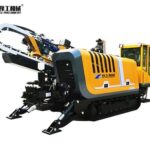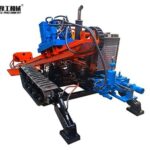HDD rig (horizontal directional drilling rig) represents a transformative advancement in underground infrastructure installation. These sophisticated machines enable the trenchless placement of pipelines, cables, and conduits with minimal surface disruption, revolutionizing traditional excavation methods. HDD machine operates on the principle of directional drilling, allowing operators to steer a drill head through subsurface soil formations while maintaining precise control over the bore path. HDD minimizes environmental impact by avoiding extensive surface disturbance.
Features of HDD Rig
- Precision Guidance: Advanced tracking systems ensure accurate bore path control even in complex terrains.
- High Power Output: Capable of handling both soft soils and hard rock formations with consistent torque and thrust.
- Environmentally Friendly: Minimal surface disruption and reduced soil displacement make horizontal directional drilling machine eco-efficient.
- Flexible Operation: Suitable for a wide range of diameters and drilling distances.
- Remote Monitoring: Some models include digital interfaces or GPS-based systems for real-time performance data.
- Safety Systems: Built-in pressure sensors and automatic shutdown functions enhance operator safety.
Structure and Main Components
A typical HDD rig consists of several core components that work together to complete the drilling and installation process efficiently:
- Drilling Rig Base Unit
This is the main power and control center of the entire machine. It contains the frame, power source, hydraulic systems, and control cabin. - Drill Head and Drill Rods
The drill head is equipped with a cutting tool designed to bore through soil and rock formations. Drill rods connect sequentially to extend the drilling depth and reach. - Mud Pump and Circulation System
Drilling fluid (commonly called drilling mud) is circulated through the borehole to lubricate the drill bit, cool the system, stabilize the hole, and transport cuttings to the surface. - Steering and Guidance System
The horizontal directional drilling machine rigs are equipped with advanced locating systems to monitor the drill head’s path underground. Operators can adjust the drilling angle and direction in real time for precise navigation.
Working Principle of Horizontal Directional Drilling Rig
The HDD rig operates through a three-stage process: pilot drilling, reaming, and pipe pulling.
- Pilot Hole Drilling
The first stage involves drilling a small-diameter pilot hole along the planned bore path. The drill head, guided by the locating system, follows a predetermined route beneath the surface. - Reaming
Once the pilot hole is complete, a reamer is attached to enlarge the borehole to the required diameter. Drilling mud continues to circulate to remove cuttings and stabilize the bore. - Pullback (Pipe Installation)
In the final stage, the utility pipe or conduit is attached to the reamer and pulled back through the hole toward the rig’s entry point. Once complete, the pipeline is securely positioned underground without disturbing the surface above.
Applications of HDD Rig
- Utility Installation: For laying water, gas, or sewage pipelines under urban landscapes without excavation.
- Telecommunication Projects: Used to install fiber optic and communication cables under roads and rivers.
- Oil and Gas Pipelines: Essential for crossing rivers, wetlands, or protected areas where trenching is impractical.
- Power Transmission: Enables underground installation of high-voltage cables with minimal land disruption.
- Infrastructure Development: Used for urban renewal projects requiring underground passage for multiple utilities.



